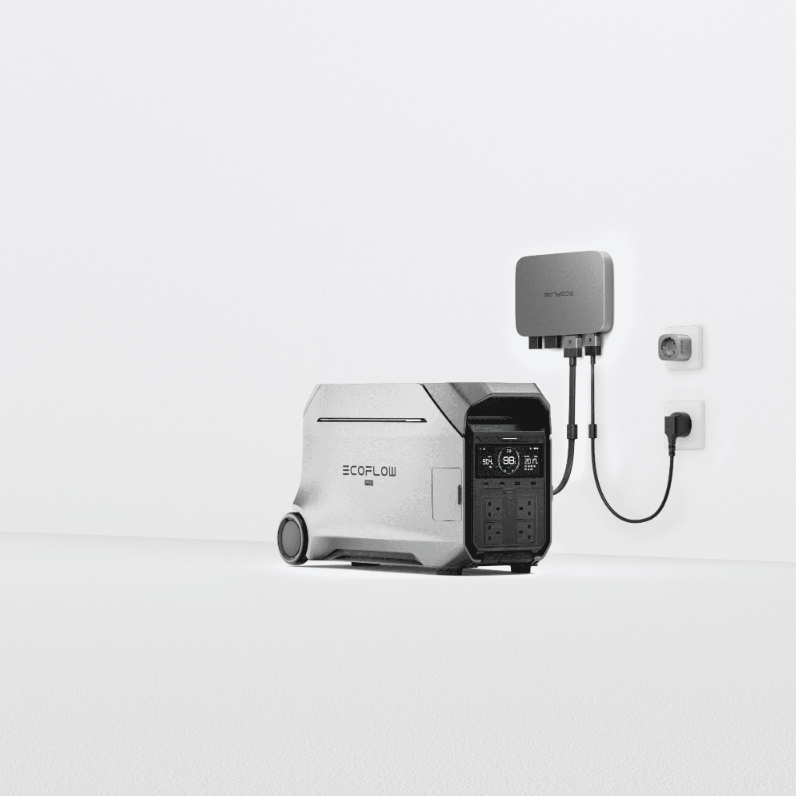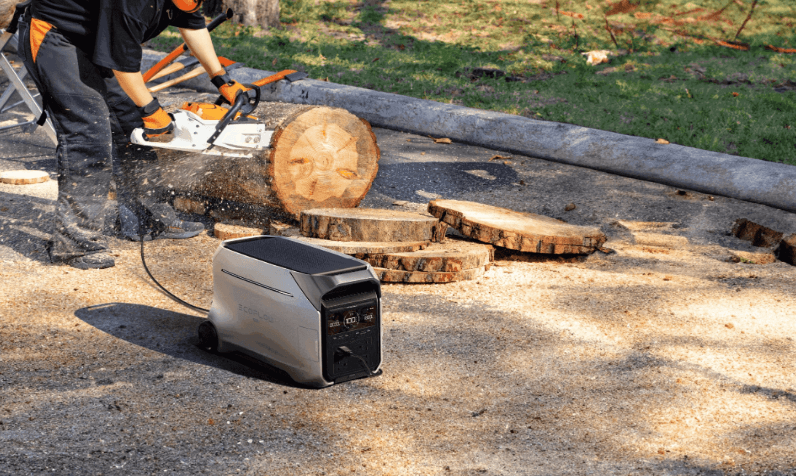What to Know Before You Buy Portable Power Stations
Portable power stations are an ideal solution for power outages, off-grid adventures, or eco-friendly backup energy. If you’ve never bought one before, you should know a few things before you officially make the investment. Understanding what it is, how it works, and what to consider as you make your purchasing decision will help you select the right one and maximize the benefits.
Below, find your complete guide to portable power stations.
What Is a Portable Power Station?
A portable power station is a rechargeable, battery-powered generator that provides electricity without using gas or fossil fuels. Unlike traditional generators, these units run quietly and don’t produce fumes, making them ideal for indoor use, travel, and eco-conscious consumers.
Essentially, they’re large, rechargeable batteries that you can use at home or on the go. Different portable power stations have different recharge options, but models like the EcoFlow DELTA 3 Plus allow AC charging from a standard outlet, car charging using the EcoFlow 800W Alternator Charger, solar charging, dual fuel charging, and combinations of these charging methods. These various charging methods provide flexibility depending on where you are and what kind of power you have access to.

How Does a Portable Power Station Work?
Portable power stations combine a rechargeable battery, an inverter, and multiple input/output ports to store and distribute power. Here’s a breakdown of the process:
Charging the Battery
For convenience, you can usually recharge a PPS using wall outlets, car adapters, or solar panels. Wall charging is usually the fastest recharge option, but solar charging allows you to power up wherever sunlight is available.
Need super-fast charging? EcoFlow models feature X-Stream fast charging technology, which can get you from 0% to 80% in under an hour on select models. It makes them among the fastest in the industry, and these quick turnaround times go a long way when urgently prepping for a storm or preparing for last-minute travel plans. By the time you’re done packing your suitcase or filling your sandbags, your PPS will be ready to go, too!
Energy Storage
Once charged, the internal battery (usually lithium-ion or LiFePO4) stores energy until needed. Some advanced models allow energy to be stored for months with minimal degradation. Once the energy is used up, you can recharge and repeat the cycle. Keeping it charged means always being ready for an energy emergency or last-minute adventures.
Powering Devices
When a device is plugged in, the inverter converts stored DC power into usable AC electricity. A PPS can run many devices, including small devices like phones and laptops, medical equipment like CPAP machines, power tools, and appliances such as refrigerators and microwaves. Larger units can easily handle heavy-duty appliances, and some can even support a home’s entire electrical load, ideal for blackouts.
Key Factors to Consider When Looking For a Portable Power Station
Choosing the best portable power station depends on your specific needs. Before you make a purchase, consider these key specs and features.
Capacity
Battery capacity (measured in watt-hours or Wh) determines how long your PPS can run devices. For example, a 1,000Wh unit can run a 60W laptop for over 16 hours. For longer runtimes or home backup, opt for robust models with expandable capacity so you can grow your power source along with your energy needs.
Output
Check the PPS wattage to ensure it can handle your devices. Continuous output matters more than surge output, but don’t overlook the surge requirements for appliances with compressors or electric motors, like refrigerators, AC units, or washing machines.
Running a 1,200W microwave requires a unit with at least that output capacity. Still, it’s wise to look for an output a little beyond what you need to provide a buffer and avoid overheating, malfunctioning, or damaging your device or appliance.
Size and Weight
Portability varies widely, and the model’s size and weight directly impact how easily it can be carried. Generally speaking, the heavier and larger the PPS, the more power it offers.
If you want to bring power along on your escapades and mobility matters to you, consider a streamlined, lightweight model like the EcoFlow RIVER 3 Plus, perfect for camping, van life, or on-the-go charging. It offers solid output in a small package, which is great news for all the weekend warriors.
If you prioritize both portability and robust power, look for a mid-range option that strikes the right balance of both.
If you plan to keep your PPS at home and don’t foresee too many remote applications, you can invest in a heavy-duty model without worrying too much about carrying it around.
Output Ports
Look for a mix of ports: AC outlets, USB-A/USB-C ports, DC car ports, and even wireless charging pads. The more ports, the more devices you can charge simultaneously, from a coffee maker to a drone charger and Wi-Fi router. The more variety of ports, the more useful it will be in matching all your cords and chargers.
Just remember, your PPS will need to support the total required wattage of all the devices plugged in at the same time. Keep that in mind as you shop the options.
Battery Type
Lithium-ion batteries are common in PPS, but LiFePO4 (lithium iron phosphate) offers better thermal stability, longer life cycles, and safer performance, especially in larger home-use models.
Other battery types in portable power stations include lead-acid, NMC (nickel-cadmium-manganese), or LiPo (lithium polymer). Some of these options, like lead-acid batteries, are cheaper, while others provide high energy density but are much more expensive.
All EcoFlow models use LiFePO4 to deliver the best safety, efficiency, and lifespan while balancing cost.
Recharge Options
Fast AC charging and solar compatibility are major advantages when shopping for a PPS. All EcoFlow models offer rapid recharge speeds and are compatible with solar panels, making them eco-friendly and cost-efficient in the long run. The more recharge options you have, the more flexibility you have in ensuring your PPS stays charged. Look for estimated AC and solar power charge times to ensure the timelines meet your needs.

Benefits of Investing in a Portable Power Station
Once you make your buying decision and start using your portable power station, you’ll also begin enjoying a myriad of benefits. Some of the top advantages are:
Reduce Carbon Footprint: PPS don’t use fuel like regular generators, so they run cleanly without producing toxic gas emissions. Pairing them with solar panels creates a zero-emission energy source, which helps reduce your environmental impact.
Requires Little Maintenance: Since there are no engine parts to maintain and no fuel or oil is needed, PPS units are virtually maintenance-free. As long as you keep them charged and store them properly, they’ll always be ready when you need them.
Pair with Solar for Free Energy: Connect your power station with solar panels, and you get self-sustaining, free energy. Use it to supplement your energy needs, stay charged on the go, or backup your home power with a robust model like the EcoFlow DELTA Pro 3.
Safe and Quiet: Portable power stations run quietly, don’t produce fumes, and pose no carbon monoxide risk, making them perfectly safe for indoor use. Feel free to use them inside for emergency home power or in enclosed spaces like tents or RVs.
Cost-Effective: While the upfront cost for a PPS may be higher than gas generators, long-term savings on fuel, maintenance, and solar compatibility make them a wise investment. Their long lifespan means you’ll have years of clean, straightforward, and potentially free electricity at your fingertips.
Frequently Asked Questions
What to Look for When Buying a Portable Power Station?
When buying a portable power station, focus on essential aspects like output, capacity, recharge time, battery type, and port options. Choose a unit that fits your lifestyle and budget, keeping in mind any energy needs you may grow into in the future.
What Are the Cons of a Portable Power Station?
High-output and large-capacity portable power stations can be more expensive upfront. They may also be quite heavy. Prolonged outages may also require external batteries or solar panels for sustained use. Still, the long-term advantages outweigh these cons, making them a good investment both now and later.
Final Thoughts
Portable power stations are revolutionizing how we store and use energy, offering clean, safe, and flexible energy for everything from emergencies to adventures. Whether you need a compact unit or a robust home backup solution, EcoFlow Portable Power Stations include a model designed to meet every need.